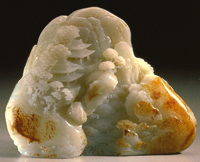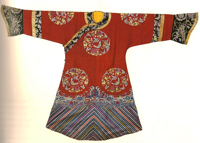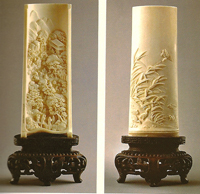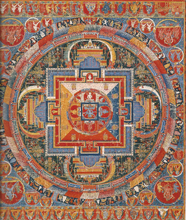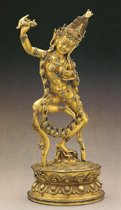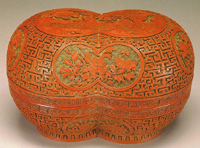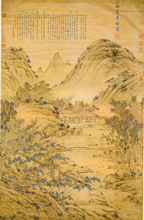Chinese Painting Aesthetics
Formats for Chinese painting vary widely over time. Ranging from massive wall-paintings, large, free-standing screens, horizontal hand scrolls, vertical hanging scrolls to folded or bound albums, as well as fans, Chinese scroll painting and calligraph are designed to secure an easy access to the viewing experience, safe storage and easy portability. For example, a horizontal hand-scroll allows the viewer to enjoy one segment of the represented (landscape, etc) at a time by unrolling from the right to the left, mysterious and entertaining. A hanging scroll format is usually hung on wall, allowing the viewer to shift position, moving in close to examine details and standing farther away to view the entire composition as a whole. In short, the choice of a format for a Chinese fine art (painting and calligraphy) takes into account the viewer's viewing experience of the represented in an emticing manner. It plays tricks on the viewer's anticipation of the viewing while boasting up the pride of the subject scroll's ownership.
Mounting styles have gone through periods of change. Chinese artists and collectors took efforts to match the style of the original work in an aesthetically pleasing manner. Chinese paintings were not considered finished until they were mounted properly. The choice of materials, usually paper, silk and satin, often reflects the rank of the signed artist, the economic means of the owner, or the intellectual taste of the collector. In other words, by looking at what you collect and how you take care of your Chinese painting and calligraphy scrolls, you are evaluated in political, economic and social context. Sometimes, the mounting style of your Chinese painting scrolls will also cast doubt on originality. Because it is not the soical norm, if a painting by a master artist were not mounted by a master mounting specialist, or not using the best material for mounting. As the materials (paper, silk or satin, etc) were easily torn, and mounting material that supporting the material, as well as two roller attached to each end may suffer conditional problems. Therefore, to having a Chinese scroll painting remounted by a later hand is a standard practice. In short, a proper mounting of a Chinese scroll painting aims to protect the pictorial surface and conserve the original beauty of the painting. The best presentation of a classical Chinese painting is to have it mounted in the proper style and use suitable mounting materials.
Understand Chinese Painting's Mounting Styles
Aesthetic Value. The mounting style contributes to the physical charm of a Chinese painting. The presentation of the painting reflects not only the skill or rank of the signed artist but also the craftsmanship of a mounting specialist and the particular taste of the owner of the scroll painting. Each painting is mounted in accord with the creative inspiration associated with the creation of the work in a historical context. For example, if a blue and green landscape (dominated by shade of bright colors), the mounting material needs to be plain and subtle to form a visual contrast for the potential viewer. If an ink landscape painting is mounted on bright colored satins, the awkwardness would shy away a true Chinese art connoisseur. In other words, an inappropriate mounting style will damage the credibility of the work and throw into question the judgment of both artist and patron. Moreover, a repeated mounting practice will certainly flatten the pictorial charm of an original work.
Conservation and Safety. A high-quality mounting prevents the painting from being damaged by improper handling and display or condition deterioration. For example, if certain herbs were added to the glue used for mounting, the scroll painting would escape insect attacks. In general, silk and paper are easily torn, broken, cracked, or damaged. Therefore, a proper conservation would enter the picture to fix the physical problems. However, in the United States, sometimes, the cost for repairing a damaged Chinese scroll painting may exceed the value of the subject scroll. If the scroll conservation is not done properly, the value of a Chinese scroll will be diminished.
Economic Considerations. Although not without cost, having your painting mounted will preserve the quality and increase the value of your painting many times over. Most Chinese scroll paintings circulating in the market are mounted in a China-based workshop, with those held in museums. Hong Kong and Taiwan are two alternatives if you wish to have a Chinese scroll painting custom-mounted. Before you commissioning a Chinese scroll restoration, it would be wise to consult a Chinese painting specialist regarding the value of your Chinese scrolls and the conservation possibilities.
What to Collect
Fine porcelain objects made during the Republican period (1911-1949) are promising. The price of quality objects of the first half of the 20th century has gone up dramatically in the past 5 years. Paying attention to the masterpieces is always wise. Trying not to be tempted by jars with a Chinese character, " Double Happiness" motif is a must. Buyers should avoid purchasing porcelain items of less than perfect condition.
Chinese paintings by female artists have potentials. This is a very profitable market for new collectors or collectors with a small budget. Chinese paintings by seventeen Chinese woman artists of the Ming (1368-1644) and Qing (1644-1911) are in demand. The smoothly rising auction sales prices suggest that the value of fine classical Chinese Paintings by Female Chinese artist will continue to grow in the coming years.
Chinese fan paintings by professional artists are collectibles. Classical Chinese paintings of a folding fan format is particularly stronger than ever as compared with the round fan format. This format has been neglected by Chinese art collectors for a long time until very recently. It is wise to focus only on quality Chinese fan paintings created prior to 1949.
Have Questions about Asian Art? Need Professional Chinese Art Consulting Service? Need Asian Art Appraisal ? Want to Know more about the Chinese Art Market ? Want to Know Where and How to sell your Art?
Our Asian Art Appraisals are conducted by Dr. Wei Yang (Ph.D. in Chinese art, a certified art appraiser and an Accredited Senior Appraiser of Asian Art designated by American Society of Appraisers). We are committed to a thorough investigation of your art work, large or small. We serve you with respect, integrity and objectivity.
Need Asian Art Consultation or Appraisal? Please Contact Us or call us at (609) 688-6891
We Consult & Appraise Asian Art
